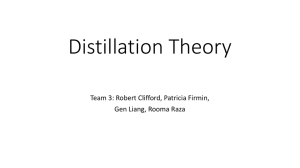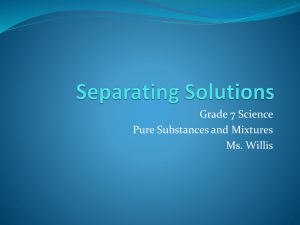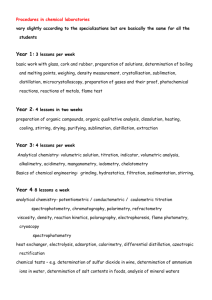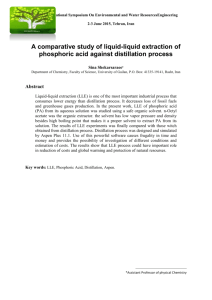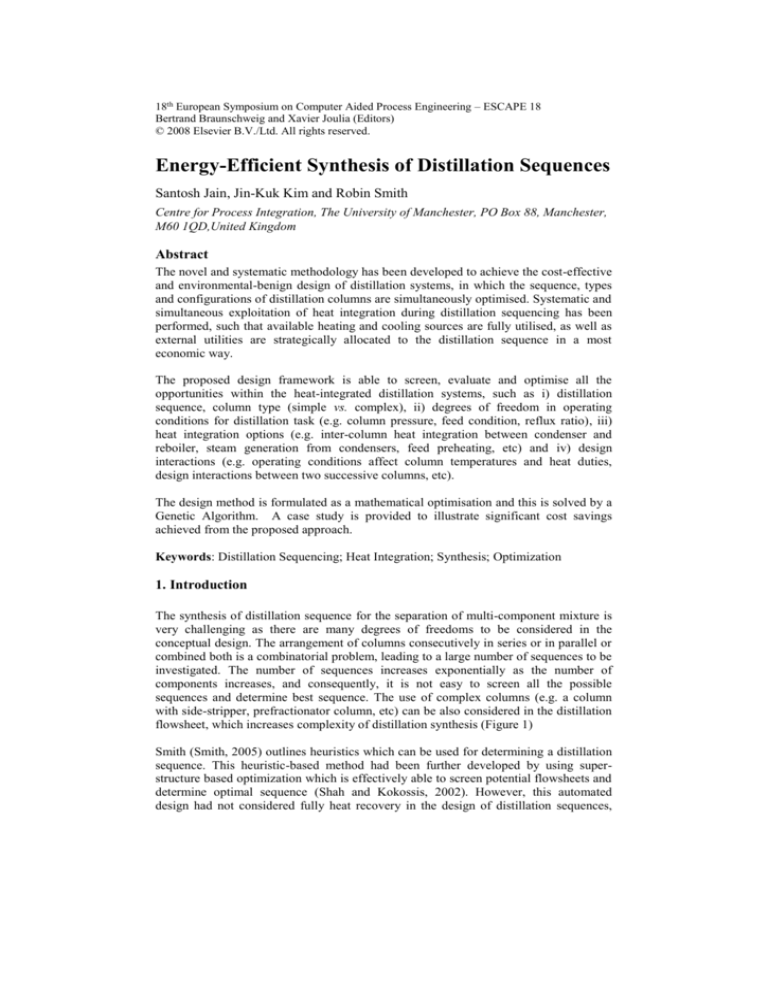
18th European Symposium on Computer Aided Process Engineering – ESCAPE 18
Bertrand Braunschweig and Xavier Joulia (Editors)
© 2008 Elsevier B.V./Ltd. All rights reserved.
Energy-Efficient Synthesis of Distillation Sequences
Santosh Jain, Jin-Kuk Kim and Robin Smith
Centre for Process Integration, The University of Manchester, PO Box 88, Manchester,
M60 1QD,United Kingdom
Abstract
The novel and systematic methodology has been developed to achieve the cost-effective
and environmental-benign design of distillation systems, in which the sequence, types
and configurations of distillation columns are simultaneously optimised. Systematic and
simultaneous exploitation of heat integration during distillation sequencing has been
performed, such that available heating and cooling sources are fully utilised, as well as
external utilities are strategically allocated to the distillation sequence in a most
economic way.
The proposed design framework is able to screen, evaluate and optimise all the
opportunities within the heat-integrated distillation systems, such as i) distillation
sequence, column type (simple vs. complex), ii) degrees of freedom in operating
conditions for distillation task (e.g. column pressure, feed condition, reflux ratio), iii)
heat integration options (e.g. inter-column heat integration between condenser and
reboiler, steam generation from condensers, feed preheating, etc) and iv) design
interactions (e.g. operating conditions affect column temperatures and heat duties,
design interactions between two successive columns, etc).
The design method is formulated as a mathematical optimisation and this is solved by a
Genetic Algorithm. A case study is provided to illustrate significant cost savings
achieved from the proposed approach.
Keywords: Distillation Sequencing; Heat Integration; Synthesis; Optimization
1. Introduction
The synthesis of distillation sequence for the separation of multi-component mixture is
very challenging as there are many degrees of freedoms to be considered in the
conceptual design. The arrangement of columns consecutively in series or in parallel or
combined both is a combinatorial problem, leading to a large number of sequences to be
investigated. The number of sequences increases exponentially as the number of
components increases, and consequently, it is not easy to screen all the possible
sequences and determine best sequence. The use of complex columns (e.g. a column
with side-stripper, prefractionator column, etc) can be also considered in the distillation
flowsheet, which increases complexity of distillation synthesis (Figure 1)
Smith (Smith, 2005) outlines heuristics which can be used for determining a distillation
sequence. This heuristic-based method had been further developed by using superstructure based optimization which is effectively able to screen potential flowsheets and
determine optimal sequence (Shah and Kokossis, 2002). However, this automated
design had not considered fully heat recovery in the design of distillation sequences,
2
Santosh Jain et. al
although the design and operation of columns has a strong impact on heat recovery.
Therefore, the new design method has been proposed in this study to obtain an optimal
distillation sequence in which energy recovery is fully integrated.
Sequence
vs
B
Complex
column
A
A
A
B
C
...
vs
vs
...
A
B
C
B
C
Simple
columns
C
Side-stripper
arrangement
Figure 1. Structural options for distillation sequence synthesis
2. Energy Recovery for Distillation Sequence
It is required that available heating and cooling sources should be fully utilized, as well
as external utilities are strategically allocated to the given distillation sequence. Energy
recovery is heavily influenced by the flowsheet of columns and its operating conditions.
For example, the choice of operating pressure for the column affects heat duty and
temperature of condenser and reboiler as well as column design (e.g. number of stages).
Steam
generation?
Feed preheating ?
Hot utility ?
Cold utility ?
Inter-column heat
recovery?
Figure 2. Options for heat recovery in distillation sequence
As seen in Figure 2, there exist many options for heat integration in distillation
sequencing:
Inter-column heat recovery: The heat from condenser from one column is
transferred to the reboiler of the other column, subject to temperature levels
and minimum temperature approach (Tmin).
Energy-Efficient Synthesis of Distillation Sequences
3
Hot utility generation: Heat from condenser(s) can be used to generate hot
utility (e.g steam) or supply heat for preheating of boiler feed water.
Use of available utility: Available utility (e.g. steam, cooling water, etc) can be
used to supply/remove heat required for reboiler/condenser.
Feed preheating: Feed to the column can be preheated by available heat from
condenser(s).
It should be noted that the splitting of heat duty for condenser and reboiler is another
degree of freedom which has been considered in the proposed method. Also, the choice
of Tmin (minimum temperature approach) is another degree of freedom for designer,
as this influences feasibility for heat transfer in exchangers as well as the required area
for heat exchange (Linnhoff et. al, 1982; Gundersen and Naess, 1990).
3. Design of Heat-integrated Distillation Sequence
It is not straightforward to consider all the options for heat integration when sequence of
distillation columns and its operating conditions are to be determined. The conventional
approach is based on a sequential synthesis procedure (Figure 3), in which first the
flowhseet for distillation sequences are screened and the most promising flowsheet is
chosen. The heat integration is then performed to design a heat recovery system. This
non-integrated method is not able to screen the whole solution space and often results in
a local optimum.
A
A
A
B
B
C
C
A
B
A
A
C
B
D
C
D
D
Step 2
B
C
D
D
B
Step 1
C
D
Heat recovery system design
Figure 3. Conventional approach for energy recovery for distillation sequence
In order to exploit benefits from simultaneous consideration of distillation sequencing
and heat integration, an automated method based on mathematical optimization has
been proposed, which systematically investigates system interactions, for example,
arrangement of distillation columns (i.e. flowsheet), use of complex columns, decision
on operating conditions, heat recovery options and costing (i.e. column and energy).
Shah and Kokossis (2002)’s method for representing distillation sequences and its
synthesis is adopted in the optimization framework. Mathematical modeling of
distillation columns is based on shortcut methods developed by Triantafyllo (1991) and
Shah (1999). For simple task, Fenske-Underwood-Gilliland method and Kirkbride
equation are used with the assumption of R/Rmin = 1.1 and constant molar overflow.
Pen-Robinson equation of state is used.
To allow convenient manipulation of heat recovery during the optimization, incidence
matrix is used to envisage heat integration matching between heat sources and sinks
4
Santosh Jain et. al
(Figure 4). Feasible or infeasible heat recovery in a distillation sequence is represented
by this matrix. The optimization model is formulated as an MINLP, and Genetic
Algorithm is employed to deal effectively with high non-linearity at the expense of
computation efforts (Figure 5). The GA optimizer proposes a series of candidate
sequences and interacts with the simulator for their assessment. An iterative procedure
built in the GA performs evaluation, comparison and ranking of design candidates,
which allows improving the optimality of solutions, and generates a set of optimal
solutions for distillation sequence with high energy recovery and low capital cost.
C2
Incidence matrix
C1
R2
R1
C3
R3
R1
R2
R3
CU1
C1
0
1
1
1
C2
0
0
1
1
C3
0
0
0
1
HU1 0
1
1
0
1: feasible heat recovery
0: infeasible heat recovery
Condenser: C1,2 and 3
Reboiler: R1,2 and 3
Hot utility: HU
Cold utility: CU
Figure 4. Incidence Matrix
Start with initial solutions
Genetic
algorithm
Generate new solutions
Sequence
simulation
NO
Heatintegration
Termination criteria met
YES
Best solutions
Figure 5. Optimization with Genetic Algorithm
4. Case Study
The developed design and optimization method is applied to the case study in which a
feed with four components are separated at minimum TAC. The feed conditions and
utility data are given in Table 1. The base case is set up by following a conventional
approach explained in the previous section. The distillation sequence is optimized at
minimum cost without considering heat recovery. This is then followed by the
optimization of heat recovery for the given distillation sequence. The resulting sequence
and its incidence matrix is given in Table 2, in which three simple columns are used to
fulfill distillation tasks required, and TAC is 1.8 MM£/yr. Condenser duty in Column 3
Energy-Efficient Synthesis of Distillation Sequences
5
is split to provide the heat for feed preheating for Column 1 and reboiler duty for
Column 2.
Feed
Utility
components
Feed mole fraction
Benzene (A)
0.25
Toluene (B)
0.25
p-Xylene (C)
0.25
o-Xylene (D)
0.25
Feed flowrate = 0.1 kmol/s
Temperature
Cooling water (CW)
25- 35 oC
LP steam (LP)
150 oC
HP steam (HP)
190 oC
Recovery (%)
99.0
99.0
90.0
90.0
Cost (£/kW·yr)
33.3
27.8
53.6
Tmin = 10 oC)
Table 1. Data for case study
Sequence
A
1.04 bar
CL2
B
CL3
2.3 bar
ABCD
CL1
1.0 bar
D
C
C1
C2
C3
LP
HP
Incidence matrix
Preheating
R1
R2
CL1
CL3
0
0
0
0
0
0
0
0
1
0
0
1
0
0
0
0
0
1
1
0
R3
CW
0
0
0
0
1
1
0
0
1
0
Table 2. Base case: Conventional approach
The optimization is carried out to synthesize simultaneously distillation sequencing and
heat integration. The optimal result is illustrated in Table 3, in which one dividing wall
column and one simple column are chosen. The energy available from condenser of
Column 2 is supplied to feed preheating and reboiler duty of Column 1. The minimum
cost for this configuration is 1.5 MM£/yr, which is 17% of improvement from the base
case. The illustrated case study demonstrates the importance for optimizing energy
recovery together with distillation sequencing, and the applicability and effectiveness of
a proposed design method.
Heat exchange with other background processes beyond distillation sequence has not
been considered in this study. However it should be noted that the concept and
methodology developed in this study is generic, which is readily applicable to combine
heat recovery with other processes.
5. Conclusion
The novel design method has been presented as the sequence of distillation columns for
multi-component mixtures is optimized with economic tradeoffs between capital cost
and energy requirements. In order to consider heat integration in the distillation
sequencing, design options for energy recovery are systematically incorporated by using
“incidence matrix” in the optimization, and most effective way of using energy is
6
Santosh Jain et. al
simultaneously optimized within distillation sequencing. Such a heat-integrated
distillation synthesis provides significant saving potentials for the design and operation
of distillation systems, as illustrated in the case study.
Sequence
Incidence matrix
A
ABCD
CL1
1.4 bar
B
C
C1
C2
LP
Preheating
CL1
0
1
0
CL2
2.3 bar
HP
0
D
Table 3. Optimal result
R1
R2
CW
0
1
0
0
0
1
1
1
0
0
0
0
References
T. Gundersen and L. Naess (1990) The synthesis of cost optimal heat exchanger
networks: An industrial review of the state of the art, Heat Recovery Systems and
CHP, 10(4), 301-328
B. Linnhoff B. et. al. (1982) User Guide on Process Integration for the Efficient Use of
Energy, IChemE, UK
P. Shah (1999) Conceptual Programming: A New Approach for the Optimisation,
Analysis and Novel Developments of Simple and Complex Separation Systems, PhD
Thesis, UMIST, Manchester, UK
P. Shah and A. Kokossis (2002) New Synthesis Framework for the Optimisation of
Complex Distillation Systems, AIChE Journal, 48, 527-550
R. Smith (2005) Chemical Process Design and Integration, John Wiley & Sons Ltd,
West Sussex, England
C. Triantafyllou (1991) The Design Optimisation and Integration of Dividing Wall
Distillation Columns, PhD Thesis, UMIST, Manchester, UK




